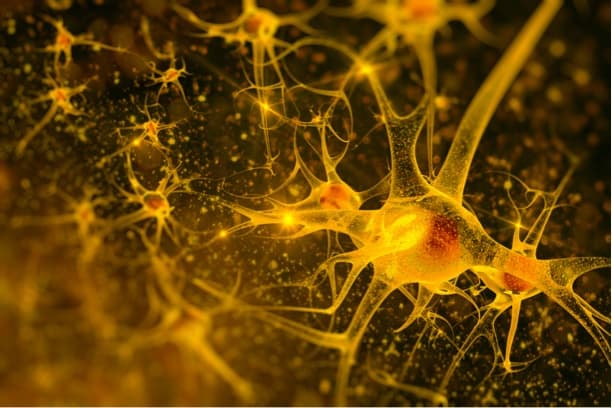Study in mice suggests that COVID-19 increases risk of developing Parkinson’s disease
Thomas Jefferson University | 05-18-2022

Brain fog, headaches, insomnia are some of the neurological symptoms doctors have observed in COVID-19 patients. Neurological sequelae after a viral infection is not new – in fact, following the 1918 influenza pandemic, it took almost a decade for patients to present with the neurological syndrome called “post-encephalic parkinsonism.” But, the mechanisms by which viruses impact the brain is poorly understood. Now, Jefferson and collaborators show in a new study performed in mice, that the SARS-CoV-2 virus responsible for the COVID-19 pandemic could increase the risk of brain degeneration seen in Parkinson’s disease.
“Parkinson’s is a rare disease that affects 2 percent of the population above 55 years, so the increase in risk is not necessarily a cause for panic,” says Richard Smeyne, PhD, Director of the Jefferson Comprehensive Parkinson’s Disease and Movement Disorder Center at the Vickie and Jack Farber Institute for Neuroscience and first author of the study. “But understanding how coronavirus impacts the brain can help us prepare for the long-term consequences of this pandemic.”
The research, published in Movement Disorders on May 17th, builds on previous evidence from the Smeyne lab showing that viruses can make brain cells or neurons more susceptible to damage or death. In that earlier study, the researchers found that mice infected with the H1N1 strain of influenza responsible for the 2009 flu pandemic, were more susceptible to MPTP, a toxin that is known to induce some of the characteristic features of Parkinson’s: primarily the loss of neurons expressing the chemical dopamine and increased inflammation in the basal ganglia, a brain region that is critical for movement. The findings in mice were later confirmed in humans by researchers in Denmark, who showed that influenza nearly doubled the risk of developing Parkinson’s disease within 10 years after initial infection.
In the current study, the researchers used mice that were genetically engineered to express the human ACE-2 receptor, which the SARS-CoV-2 virus uses to gain access to the cells in our airway. These mice were infected with SARS-CoV-2 and allowed to recover. Importantly, the dose chosen in this study corresponds to moderate COVID-19 infection in humans, with around 80 percent of the infected mice surviving. Thirty-eight days after the surviving animals recovered, one group was injected with a low dose of MPTP that would not normally cause any loss of neurons. The control group was given saline. Two weeks later, the animals were sacrificed and their brains examined.
The researchers found that COVID-19 infection alone had no effect on the dopaminergic neurons in the basal ganglia. However, mice that were given the low dose of MPTP after recovering from infection exhibited the classic pattern of neuron loss seen in Parkinson’s disease. This increased sensitivity after COVID-19 infection was similar to what was seen in the influenza study; this suggests that both viruses could induce an equivalent increase in risk for developing Parkinson’s.
“We think about a ‘multi-hit’ hypothesis for Parkinson’s – the virus itself does not kill the neurons, but it does makes them more susceptible to a ‘second hit’, such as a toxin or bacteria or even an underlying genetic mutation,” explains Dr. Smeyne.
Both influenza and SARS-CoV2 have been found to cause a “cytokine storm” or an overproduction of pro-inflammatory chemicals. These chemicals can cross the blood-brain barrier and activate the brain’s immune cells – microglia. Indeed, the researchers found increased numbers of activated microglia in the basal ganglia of mice that recovered from SARS-CoV2 and received MPTP. While the mechanism is not fully understood, the researchers believe the increased microglia inflame the basal ganglia and cause cellular stress. This then lowers the neurons’ threshold to withstand subsequent stress.
This study was co-led by collaborator Peter Schmidt, PhD, a neuroscientist from New York University. “We were concerned about the long-term consequences of viral infection,” Dr. Schmidt said. “Dr. Smeyne is a leader in this area of research and Jefferson was the ideal site to perform the analysis.”
The researchers are planning to determine whether vaccines can mitigate the experimental increase in Parkinson’s pathology linked to prior SARS-CoV-2 infection. They are also testing other variants of the virus, as well as doses that correspond to milder cases in humans.
While their findings thus far bolster a possible link between the coronavirus and Parkinson’s disease, Dr. Smeyne says there are some important caveats. “First of all, this is preclinical work. It is too soon to say whether we would see the same thing in humans, given that there seems to a 5-10 year lag between any changes in clinical manifestation of Parkinson’s in humans.” This lag, he says however, could be used to our advantage. “If it does turn out that COVID-19 increases the risk of Parkinson’s, it will be a major burden on our society and healthcare system. But we can anticipate that challenge by advancing our knowledge of potential ‘second hits’ and mitigating strategies.”
Source:
Materials provided by Thomas Jefferson University. Content may be edited for clarity, style, and length.
